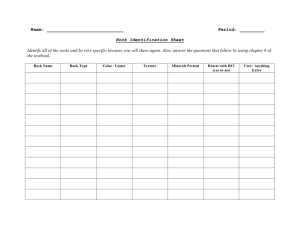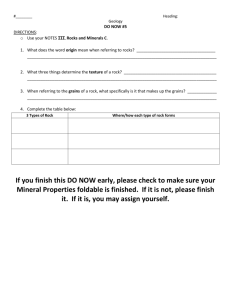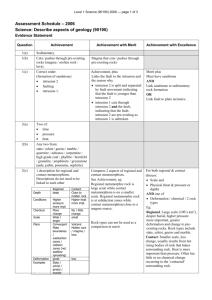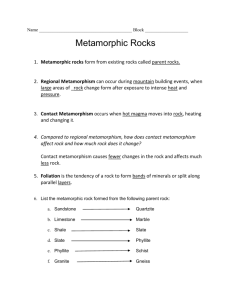Multiple Choice 3. ______ is a major dissolved volatile constituent in
advertisement
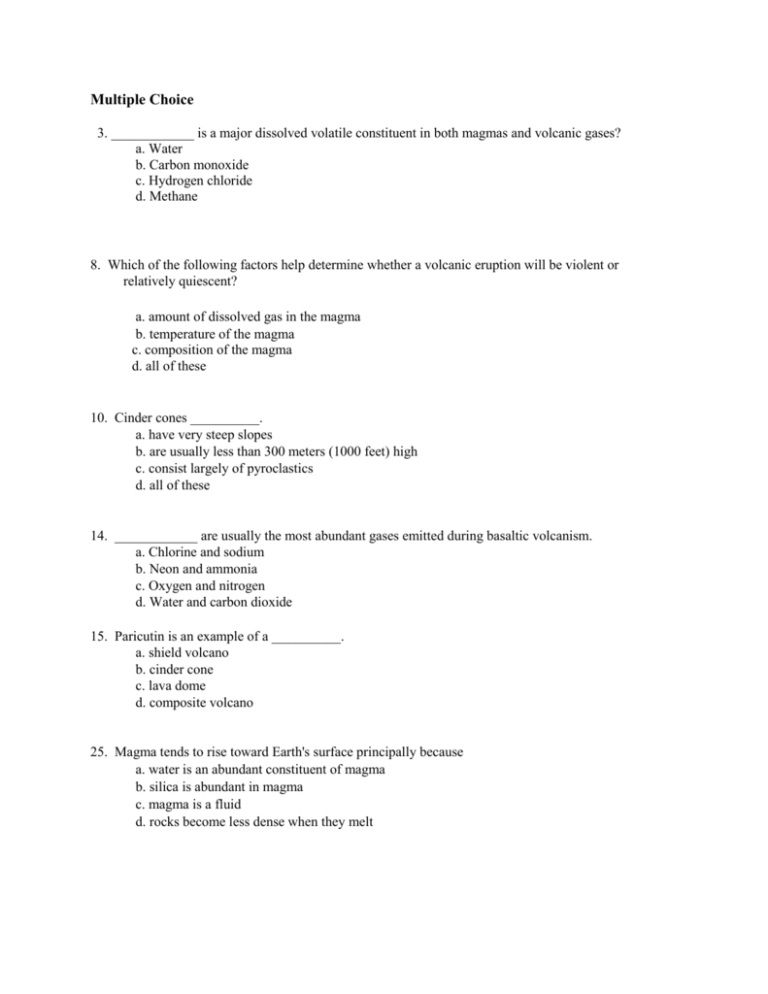
Multiple Choice 3. ____________ is a major dissolved volatile constituent in both magmas and volcanic gases? a. Water b. Carbon monoxide c. Hydrogen chloride d. Methane 8. Which of the following factors help determine whether a volcanic eruption will be violent or relatively quiescent? a. amount of dissolved gas in the magma b. temperature of the magma c. composition of the magma d. all of these 10. Cinder cones __________. a. have very steep slopes b. are usually less than 300 meters (1000 feet) high c. consist largely of pyroclastics d. all of these 14. ____________ are usually the most abundant gases emitted during basaltic volcanism. a. Chlorine and sodium b. Neon and ammonia c. Oxygen and nitrogen d. Water and carbon dioxide 15. Paricutin is an example of a __________. a. shield volcano b. cinder cone c. lava dome d. composite volcano 25. Magma tends to rise toward Earth's surface principally because a. water is an abundant constituent of magma b. silica is abundant in magma c. magma is a fluid d. rocks become less dense when they melt 28. Mount St. Helens is ____________. a. a basaltic cinder cone b. an explosive composite cone c. a basaltic shield volcano d. a small, welded tuff cone 31. A ______ volcano is a very large, gently sloping mound composed mainly of basaltic lava flows. a. composite b. stratospheric c. cinder cone d. shield 38. Which of the following is NOT considered pyroclastic debris? a. ash b. cinders c. bombs d. pahoehoe 40. Which one of the following shows the correct order (left to right) of decreasing magma viscosity? a. granite, andesite, basalt b. andesite, granite, basalt c. basalt, granite, andesite d. basalt, andesite, granite 2. Which of the following is not a fundamental particle found in atoms? a. neutron b. selectron c. electron d. protons 4. Atoms that have an electrical charge due to a gain or loss of electrons are called __________. a. isotopes b. ions c. isochrons d. periodic elements 5. Which of the following is correct for isotopes of the same element? a. the atoms have different numbers of protons and the same number of neutrons b. the atoms have the same number of electrons and different numbers of protons c. the atoms have different numbers of neutrons and the same number of protons d. the atoms have different numbers of electrons but the same number of neutrons 6. What mineral is the hardest known substance in nature? a. silicate b. native gold c. diamond d. muscovite 7. Which carbonate mineral reacts readily with cool, dilute hydrochloric acid to produce visible bubbles of carbon dioxide gas? a. calcite b. quartz c. gypsum d. plagioclase 8. Which common mineral is composed entirely of silicon and oxygen? a. calcite b. diamond c. olivine d. quartz 9. Which of the following minerals is a silicate? a. hematite b. feldspar c. calcite d. halite 11. Which one of the following mineral groups exhibits a sheet-like silicate structure? a. carbonates b. pyroxenes c. micas d. feldspars 13. The resistance of a mineral to abrasion is known as __________. a. luster b. cleavage c. streak d. hardness 14. All silicate minerals contain which two elements? a. iron, silicon b. silicon, sodium c. oxygen, carbon d. silicon, oxygen 16. What element is the most abundant in the Earth’s crust by weight? a. carbon b. chlorine c. oxygen d. sodium 17. The strong tendency of certain minerals to break along smooth, parallel planes is known as ________. a. streak b. cleavage c. cracking luster d. crystal form 18. An atom’s mass number is 13 and its atomic number is 6. How many neutrons are in its nucleus? a. 19 b. 7 c. 13 d. 6 20. Which group of minerals are the most abundant in the Earth’s crust? a. sulfides b. carbonates c. silicates d. halides 23. Which of the following describes the light reflecting and transmission characteristics of a mineral? a. luster b. color streak c. virtual absorption d. fluorescence 25. Which of the following is NOT one of the eight most common elements in Earth’s crust? a. carbon b. potassium c. aluminum d. calcium 2. As the rate of cooling increases, the size of the crystals that form __________. a. increases b. decreases c. is not affected d. none of these 3. Which one of the following is an igneous rock? a. limestone b. rhyolite c. slate d. shale 4. Intrusive rocks __________. a. are generally fine-grained b. form at Earth’s surface c. are quite often vesicular d. none of the above 5. Granite and gabbro __________. a. have a similar mineral composition b. have a similar texture c. both a and b d. are in no way similar 6. Obsidian exhibits a(n) __________ texture. a. fine-grained b. glassy c. coarse-grained d. porphyritic 8. This igneous texture is characterized by two distinctively different crystal sizes. a. fine-grained b. glassy c. coarse-grained d. porphyritic 9. Rhyolite is the fine-grained equivalent of this igneous rock. a. basalt b. andesite c. granite d. diorite 14. Igneous rock is formed a. by the weathering of pre-existing rocks b. by changes in mineral composition c. at great depth within Earth d. by crystallization of molten rock 21. Sedimentary rocks __________. a. may contain fossils b. hold important clues to Earth’s history c. may be economically important d. all of the above 22. Detrital sedimentary rocks are classified (named) primarily on the basis of __________. a. color b. type of bedding c. composition d. particle size 25. Which pair of minerals is most common in detrital sedimentary rocks? a. quartz and olivine b. calcite and clay c. clay and quartz d. dolomite and gypsum 28. The most abundant chemical sedimentary rock is __________. a. limestone b. dolomite c. chert d. rock salt 31. Metamorphism may result from __________. a. heat b. pressure c. chemical action d. all of these 32. ____________ is a strong, parallel alignment of different mineral bands in a metamorphic rock. a. Rock cleavage b. Foliation c. Stress streaking d. Marbleizing 34. The common rock produced by the metamorphism of limestone is __________. a. marble b. mica schist c. phyllite d. gneiss 35. __________ is composed of alternating bands of light and dark silicate minerals. a. marble b. mica schist c. phyllite d. gneiss 36. This dense, nonfoliated metamorphic rock is produced most often from sandstone. a. phyllite b. mica schist c. quartzite d. marble 37. The agents of metamorphism are __________. a. uplifting and folding b. foliation and deposition c. contact and regional deformation d. heat, pressure, and chemical fluids 39. What type of metamorphic rock will shale normally become following low-grade metamorphism? a. marble b. mica schist c. slate d. gneiss 40. Which of the following lists the rocks in the order of increasing grain size and increasing grade of metamorphism? a. gneiss, slate, schist b. schist, slate, gneiss c. slate, gneiss, schist d. slate, schist, gneiss 4. ____________ have the highest velocities. a. Primary waves b. Secondary waves c. Surface waves d. Refracted S waves 6. The amount of destruction caused by earthquake vibrations is affected by __________. a. design of structures b. intensity and duration of the vibrations c. nature of the surface material d. all of these 14. Overall, this type of seismic wave is the most destructive. a. P wave b. S wave c. surface wave d. tsunami 15. Approximately how much more energy is released in a 6.5 Richter magnitude earthquake than in one with magnitude 5.5? a. 3000 times b. 3 times c. 300 times d. 30 times 16. P waves ____________. a. propagate only in solids b. are faster than S waves and surface waves c. have higher amplitudes than do S waves d. produce the strongest ground shaking 28. The average composition of the oceanic crust is thought to approximate that of __________. a. granite b. basalt c. peridotite d. iron 29. The average composition of the continental crust most closely approximates that of __________. a. granite b. basalt c. peridotite d. iron

